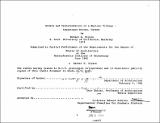| dc.contributor.advisor | Imre Halasz. | en_US |
| dc.contributor.author | Olguin, Rafael G | en_US |
| dc.contributor.other | Massachusetts Institute of Technology. Dept. of Architecture. | en_US |
| dc.coverage.spatial | n-mx--- | en_US |
| dc.date.accessioned | 2008-11-07T18:45:13Z | |
| dc.date.available | 2008-11-07T18:45:13Z | |
| dc.date.copyright | 1982 | en_US |
| dc.date.issued | 1982 | en_US |
| dc.identifier.uri | http://hdl.handle.net/1721.1/42958 | |
| dc.description | Thesis (M. Arch.)--Massachusetts Institute of Technology, Dept. of Architecture, 1982. | en_US |
| dc.description | MICROFICHE COPY AVAILABLE IN ARCHIVES AND ROTCH. | en_US |
| dc.description | Bibliography: p. 69-71. | en_US |
| dc.description.abstract | In Mexico today there is an accelerated migration of skilled organized labor from urban centers to rural settlements. This is primarily due to the increased exploitation of natural resources in rural regions and the establishment of new highway networks required to transport the goods. This thesis deals with the growth problems of the settlements resulting from the additional population and new functional demands. The major thrust of this work concentrates on a feasible proposal for a dwelling type that accommodates the new expansion and insures the architectural character of the existing village is preserved. The design decisions are based on information obtained through my on-site research and documentation of the physical form of a specific village, Ixpantepec Nieves, Oaxaca, Mexico. Constancy and change elements of the physical environment were major concerns in providing the design alternative. How can a place adapt to changing needs of public and private life and still retain its identity? My investigation of this question resulted in the ensuing alternative, having generic potential as it interprets the character of the settlement, brings about meaningful change and relates to local values. After studying the context of an existing village, projected physical growth assumptions were applied and architectural design principles were implemented to produce a design integrating the theme and variation of the repetitive rectangular building form found throughout the settlement allowing for individual identity and conservation of the "spirit of the place." | en_US |
| dc.description.statementofresponsibility | by Rafael G. Olguin. | en_US |
| dc.format.extent | 72 p. | en_US |
| dc.language.iso | eng | en_US |
| dc.publisher | Massachusetts Institute of Technology | en_US |
| dc.rights | M.I.T. theses are protected by
copyright. They may be viewed from this source for any purpose, but
reproduction or distribution in any format is prohibited without written
permission. See provided URL for inquiries about permission. | en_US |
| dc.rights.uri | http://dspace.mit.edu/handle/1721.1/7582 | en_US |
| dc.subject | Architecture. | en_US |
| dc.subject.lcsh | Housing, Rural Mexico Oaxaca | en_US |
| dc.subject.lcsh | Rural-urban migration Mexico | en_US |
| dc.title | Growth and transformation of a Mexican Village : Ixpantepec Nieves, Oaxaca | en_US |
| dc.type | Thesis | en_US |
| dc.description.degree | M. Arch. | en_US |
| dc.contributor.department | Massachusetts Institute of Technology. Department of Architecture | |
| dc.identifier.oclc | 09032828 | en_US |
